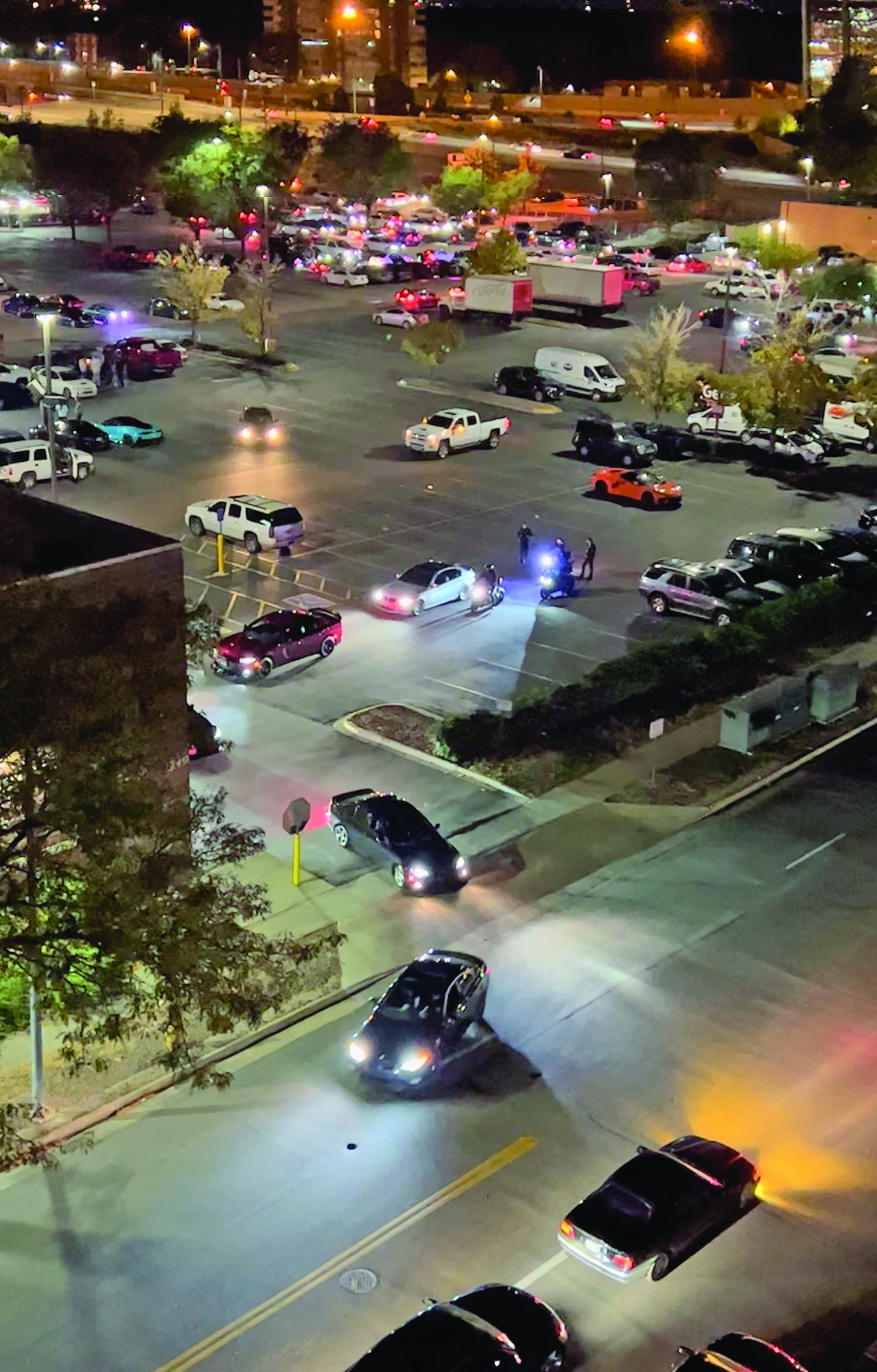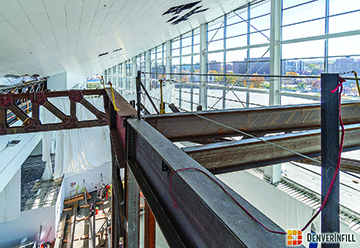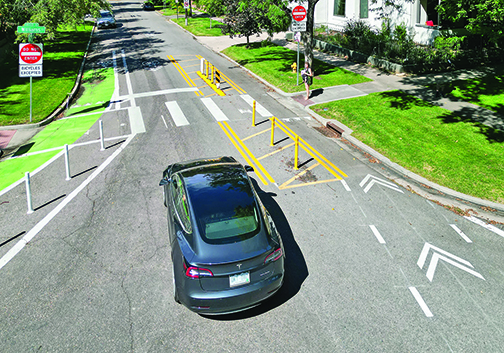
by Valley Gadfly | Nov 16, 2023 | Main Articles
Bike Lanes Pedal Past Cracked, Crumbling Sidewalks As City Council Delays Repair Due To A ‘Built-In Bias’
by Glen Richardson

Small Roundabouts Big Problem: New “bikeway” roundabouts are causing accidents and slowing the response time for emergency vehicles. Denver Fire has paused its approval.

Reworked Doesn’t Work: Reconfigured bike lanes cut across and to the side of the 7th Ave. & Williams intersection. A blind spot caused resident Jan Douglas to take a spill. Photo: Channel 7, KMGH-TV

Disorderly Design: Bike lane intersection designs by Denver’s DOTI are creating chaos for motorists, pedestrians, and bicyclists. This helter-skelter design is at 7th Ave. and Williams St.
If sidewalks are for pedestrians, why did Denver’s bicycle lobby campaign for a sidewalk tax?
Biking advocates — using the name Denver Streets Partnership — launched the 307 Campaign in Aug. 2022 promoting “Denver Deserves Sidewalks.” The campaign claimed it would remove the responsibility for repairs from adjacent property owners and place the responsibility on the City of Denver. Through a “modest annual fee” citywide construction and repair of sidewalks would be underway and finished in nine years.
Passing with 55.85% of the vote last November, residents using wheelchairs, crutches, canes, plus those with visual or cognitive impairment, would soon be using sidewalks. So would children and older pedestrians with reduced motor skills.
Fee Collection Delayed
A year later there are still no sidewalk repairs, nor will there be any until at least until July of next year. The Denver City Council has voted to delay property owner collection fees until July 1, 2024. That’s more than 18 months after voter approval and six months after it was initially scheduled to begin.
City Council decided on the delay due to rising concerns expressed by prope

Chic Lanes Vs. Cracked Sidewalks: These hypothetical, idealized bike lanes are planned to be imposed throughout the city. Pedestrians and wheelchair users continue to watch their step as the gulf between the two uses widens.
rty owners. Increasingly, property owners told council members the Streets Partnership built bias and discrimination into the plan.
“I am part of the unfortunate 15% of people who will be paying over $400 a year in sidewalk fees simply because I am unlucky enough to live on a corner lot,” says Erin Feldman. Like so many others, Feldman urged City Council not to roll the plan out without further consideration and planning. “They’re gross inequities in the plan and it is an unfair burden for people like me,” she tells the Chronicle.
Hit On Homeowners?
Before the Denver Deserves Sidewalks initiative passed in 2022, property owners were responsible for maintaining their own sidewalks as needed. The new Street Partnership funding structure instead collects money from homeowners based on linear footage of the property, wealth of the neighborhood, and if the home is on a corner lot.
Homeowners being responsible for their own sidewalks is akin to how other big cities take care of sidewalks. In Chicago, property owners and the city share the cost of replacing sidewalks. The cost per square foot to property owners is well below what a private contractor would charge. Through their Sidewalks Repair Program, New York City performs free repairs for qualifying broken sidewalks.
Advocates still claim the change is a safety and accessibility win in a city with so many broken and nonexistent sidewalks. But questions remain about how long the rollout will take, how much the program will actually cost, and what will done about properties with extremely high fees.
Sudden Switcheroo
Duped, misled, hoodwinked?
Throughout the campaign the Denver Streets Partnership promoted itself as a local street safety advocacy group. Today, however, the Street Partnership and Jill

Sad Sidewalk Symbol: Larimer Girl mural by local artist Jeremy Burns seems to suggest sadness and disappointment in Denver’s sidewalks.
Locantore, the executive director, are staff members of the nonprofit advocacy organization Bicycle Colorado. WalkDenver has also merged with Bicycle Colorado. Staff members of the former groups still claim to support sidewalk improvements.
As the state’s political advocacy group for bikers, Bicycle Colorado helped pass Denver ballot measure 2A, creating the state’s first eBike subsidy. The city’s E-Bike rebates are designed to build an army of bike lane advocates. They also helped to get $12 million for the eBike subsidy program inserted into the Clean Air Grant program; and added over $1 billion in funding to the statewide transportation bill. Moreover, Bicycle Colorado has funded and promoted the increasingly controversial 196 miles of on-street bike lanes in Denver.
Biker Bunny Hop
The Denver 307 Campaign’s promise to repair deteriorating sidewalks still awaits the overhaul to begin. So does the construction of new sidewalks where needed, or upgrading walks to ADA standards.
Nonetheless, the bike lobby continues to bunny hop over the city’s cracked sidewalks, adding 24 miles of painted bike lanes, 45 miles of buffered bike lanes, 23 miles of protected bike lanes, and 34 miles of neighborhood bikeways. Cost to the city so far is $13.4 million.
In addition, critics claim Denver’s Department of Transportation & Infrastructure (DOTI) is primarily giving bikers multiple ways to get around town, rather than a system for all people.
Bike Lane Impact
Denver expanded the ways the streets are used without being able to expand the streets. Their width is unchanged, but on many blocks, traffic lanes were narrowed to create space for a bike lane. On streets with protected bike lanes, a narrow buffer has also been squeezed in, making the traffic lanes even thinner.
Detractors say that due to being poorly planned, narrower streets in Denver are filled with cars and “mostly empty” bike lanes.
Denver and other cities were never intended to accommodate bike lanes, they argue. They also claim bike lanes make the worst common cycling accidents more common. Adding them also reduces parking spaces for cars and increases traffic jams. The debate also reflects tension over the future of cities, and anxiety over a new pattern of urban planning that no longer prioritizes the automobile.
Bike Owners Vs. Lobby
Albeit a powerful city-state political money moocher, Bicycle Colorado represents a small segment of Denver’s biking community. Most of the approximately 560,000 metro bicycle owners don’t participate in or fathom what the organization does.
Denver has had 889 bicycle thefts reported so far this year. Despite averaging 96.2 robberies per month, the lobby does little more than proclaim they “provide a voice for people who ride bicycles.”
Bike to Work Day — the free Denver Regional Council of Governments backed event — had 17,981 riders in 2023. A Winter Bike to Work Day in 2024 is set for Friday, Feb. 9, followed by the Wednesday, June 16, Bike to Work Day.

by Heather Brecl | Nov 16, 2023 | Main Articles
by Heather Brecl

Noisy late-night car rallies in Denver parking lots in residential neighborhoods are causing residents to feel unsafe and unnerved at home.

Loud mufflers and cars peeling out in a never-ending parade of people coming and going from the rally in front of residential buildings.
Denver residents living next to the big box store parking lots in Denver and Glendale are sadly familiar with sleepless nights caused by racecar rallies that seem to never end. Beginning long after dark and lasting until the wee hours, the loud and highly disruptive car rallies pop up monthly on a seemingly unexpected weekend night.
Unfortunately, these gatherings are becoming a more regular occurrence and are creating a sense of lawlessness, making residents fear for the safety of themselves and their loved ones returning home late at night. Denver resident Margaret W. (last name withheld upon request) lives in apartments that overlook the parking lot where Best Buy and Hacienda are located, at the corner of I-25 and Colorado Blvd. She said that her teenage daughter works at a local restaurant and often works the evening weekend shift. She is extremely fearful for her safety as she returns home from a long night’s work not knowing what she’ll encounter and cannot safely make her way up the street to the parking lot of their building.
From her balcony, she watched the cars screech both into and out of the parking lot circling up and down the street, completely ignoring any pedestrians walking by or residents trying to come and go in the neighborhood. So far, the police have been unable to do anything to stop the madness. “The people who gather at these rallies on nights when there is usually a big event somewhere downtown — they know that the cops won’t come since there are bigger problems to address,” said Margaret W. “They are getting braver, louder, and more reckless as the weeks go on. I’m getting to the point where I dread the weekends, knowing that there might be another rally.”
Glendale City Manager and attorney Chuck Line stated that “these late-night car rallies are examples of the general lawlessness created by the decriminalization of everything. They are just symptoms of the same disease. By decriminalizing things like shoplifting, people feel as if they can get by with whatever they want and they participate in behavior that they wouldn’t normally do. There just aren’t consequences anymore for doing the wrong thing.”
He recalled seeing gatherings of car enthusiasts that he saw posted in the neighborhood decades ago that were called “Coffee and Cars” with sanctioned gathering spaces. People who thought about peeling out for the thrill of it stopped doing it because they didn’t get by with the behavior. The late-night car rallies today teeter constantly on the edge of illegal behavior with reckless driving, noise violations, and endangerment of people living in these communities.
Margaret W. said there was yet another pop-up late night rally in the Best Buy parking lot with hundreds of cars, food trucks, and screeching tires as people slowly but steadily entered and then exited the lot lining up on East Mexico Avenue on their way back to I-25. Distressed and unable to fall asleep until 2 a.m., Margaret listened to the deafening music and roaring engines for over four hours, followed by the sounds of cars peeling out and racing one after the other onto I-25 headed northbound.
Discouraged and feeling helpless, Margaret has made countless calls to the non- emergency police number, hoping to get some peace back in her neighborhood where she has lived for over seven years. “I am very sad to see what is happening on a regular basis right across from my doorstep. I don’t feel safe anymore and wish I could do something to make the nonsense stop.” To her dismay, her calls to authorities have been fruitless and she has been unable to get any police presence to try and control the situation.
Line emphasized that the city is deeply committed to the welfare of their residents and community. “We are and will continue to be vigilant in responding to any calls we receive about these rallies and will take measures to do whatever we can to keep people safe. We encourage anyone witnessing these happenings and who have concerns to make calls to the non-emergency police number to report what they see and hear. Together we can get on top of this. If you feel like there is something illegal happening, please call.”
For local businesses, dealing with the rallies is a precarious situation. While they are not sanctioned by the businesses, the public is free to both park and gather in the parking lots. And certainly, not everyone participating in the car rally is engaging in criminal activity. This puts business owners in a difficult position as they do not want to discourage people who may be there just to stop or do business but want to make sure that their community remains a safe and welcoming place for their patrons.
Margaret W. remains hopeful that other residents will speak up letting authorities and business owners know how they feel so that her neighborhood will continue to be a place that she wants to call home.
The non-emergency police number for Glendale is 303-759-1511 and for Denver, dial 720-913-2000.

by Jessica Hughes | Oct 20, 2023 | Main Articles
 by Jessica Hughes
by Jessica Hughes
Colorado’s largest fashion event is back. Denver Fashion Week hits the runway on November 11, 2023, with the largest lineup of local emerging and established local designers.
Named by Forbes as “a trusted alternative to New York for emerging talent” and featured in ELLE, DFW is the city’s largest fashion event bringing together an eclectic array of new and seasoned designers with local boutiques, hair stylists, make-up artists, and models. Denver Fashion Week has been in production since its inaugural show in 2012 with the goal of supporting Denver’s fast-growing fashion industry. In 2018, DFW partnered with Denver Arts & Venues and VISIT DENVER to become Denver’s first official fashion week.

Kids take the runway with designs from Rainey’s Closet at the DFW Kid’s Fashion Show.
“Each season, we help new models get into the industry, supporting designers to break into the industry, working with Visit Denver to bring tourism to Denver, and putting Denver on the national fashion map as seen in Forbes and Elle Magazine,” says the Aharonian Family, founder and producer of Denver Fashion Week.
For the first time ever, DFW will be held at the York Street Yards in Denver. The 2023 fall line-up features six runway shows, the Southwest Hairstyling Awards, and a Model Industry Workshop. Highlights include eight days of fashion events, 36 local designers, 500+ models, the longest DFW runway to date with the largest LED runway backdrop, and brand-new lighting design.
“Once again, we’re elevating the experience for Denver Fashion Week with the fall shows,” says the Aharonian Family. “We’re excited to introduce the longest runway we’ve had since the show began with a completely fresh lighting design at an incredible new venue. We’re also pleased to introduce our new runway producers Nikki Strickler

Walking the runway in Geo in Style x Lasha Jokhadze at Denver Fashion Week Couture show.
and Hailee Lucchesi, and welcome new and returning designers.”
The show will feature emerging and established local, national, and international designers and boutiques showcasing their collections’ key seasonal styles. Kicking things off will be DFW’s largest international designer yet — St. John. The Sustainable show will be held on National Recycling Day (Nov. 15) and will feature nine local designers.
Fashion designers to look out for include Max to the Couture — the first fashion week for the seven-year-old ingenue designer showing his first collection in any fashion week here in Denver on Nov 18. Also keep your eye out for the Emerging Designer Challenge winners, J. Lin Snyder and Okime Kollections — both Denver-based.
The Streetwear and Sneakers show will feature one of the Emerging Designer Challenge winners, Okime Kollections, and an emerging local artist MCT who will be introducing his wearable art line at the show — with many of the art pieces that inspired his fashion pieces.
Society show will feature the other Emerging Designer Challenge winner, J Lin Snider.
In addition to the runway shows, enjoy a two-hour red carpet cocktail party before each show, where you can mingle with likeminded, top media personnel, and local celebs. Taste some of Denver’s top restaurants in the VIP room, and don’t forget to come dressed in different fashion attire based of the theme of each show.
Denver Fashion Week Schedule:
Saturday, Nov. 11 – Ready to Wear by St. John
Sunday, Nov. 12 – Southwest Hairstyling Awards
Monday, Nov. 13 – Fashion Model Industry Workshop
Tuesday, Nov. 14 – Streetwear &

Cherry Creek Dance at the Denver Fashion Week celebrating kids’ fashion.
Sneakers
Wednesday, Nov. 15 – Sustainable
Thursday, Nov. 16 – Society
Saturday, Nov. 18 – Couture
Sunday, Nov. 19 – Kids Fashion Show
You can learn more at denverfashionweek.com.
All images from Denver Fashion Week

by Valley Gadfly | Oct 20, 2023 | Main Articles
Eateries Open For Thanksgiving, Plus Fun Things To Do In Legs Up Guide By Neighborhood For A Bountiful Holiday
by Glen Richardson

Hot To Trot: Plan to join United Way’s 50th anniversary Thanksgiving 4-mile Turkey Trot or 1-mile Lil Gobbler family run at Wash Park Nov. 23, 9 a.m.
November is the month to celebrate happiness and home as we prepare for Thanksgiving. The popular holiday falls on Thursday, Nov. 23, this year. If laboring in the kitchen doesn’t sound like your idea of a holiday, let chefs and professional restaurant staff prepare and serve your Thanksgiving meal.
Many restaurants are opening their doors to serve up a variety of gourmet dishes. Reminiscing with friends and kin will touch your Funny Bone as you enjoy the annual Wish Bone holiday. Choices range from Monaco Inn Restaurant’s flavorful fare, to the buffet at FIRE in the ART Hotel.
Here’s the Chronicle’s leg up Thanksgiving guide to restaurant options and fun things to do to make your holiday bright and bold:
Dining Out Options
Listed by neighborhoods, these restaurants have signified they will be open for Thanksgiving. Many, however, had yet to announce menu choices.
Glendale-Cherry Creek
Blue Island Oyster Bar, Seafood
Del Frisco’s Grille, Steakhouse
Bar-grill on St. Paul annually offer a three-course turkey dinner, 11 a.m. to 9 p.m. Information: 303-320-8529.
Gyo-Kaku, Japanese
Hapa Sushi Grill, Sushi
Hana Matsuri, Sushi
Jax Fish House & Oyster Bar, Seafood
Kini’s
La Merise, French
Little Ollie’s, Asian
Local Jones, American
Bistro-bar in Halcyon Hotel annually offers dine in or advanced notice to-go orders. They often feature a one-of-a-kind Pumpkin Basque Cheesecake dessert. Information: 720-772-5022.
Locanda Del Borgo, Italian
Mehak India’s Aroma
Monaco Inn Restaurant, Greek
Though it’s known for its Greek cuisine, this cozy holiday dining institution always offers a Thanksgiving feast. Eatery is serving classic roast turkey with stuffing and all the trimmings, noon to 6 p.m. Menu items are also available, all accompanied by classic sides. Information: 303-320-1104.
Narrative
North Italia
Quality Italian
Toro Latin Kitchen, South American
True Food Kitchen
Viale Pizza & Kitchen, Italian
Downtown
801 Fish, Seafood

Family & Friends Feast: Experience the quality and service of the Monaco Inn Restaurant this Thanksgiving. Family run Monaco Square eatery has been serving Denver for over 30 years.
Corinne, American
Restaurant in the Le Meridien Hotel is serving from 11:30 a.m. to 10:30 p.m. Choose from roasted turkey, bourbon glazed ham, tofurkey as an entrée. Limited a la carte options from menu also offered. Information: 720-996-1555.
Corner Office Restaurant, American
Eatery in downtown Curtis Hotel annually offers a Thanksgiving buffet. Information; 303-825-6500.
EDGE Restaurant, Steakhouse
Steakhouse in Four Seasons Hotel downtown is serving a Thanksgiving buffet featuring “savory delicacies and decadent desserts,” from noon to 8 p.m. Information: 303-389-3050.
Guard & Grace, Steakhouse
Ship Tavern Brown Palace, American
STK, Steakhouse
Three Saints Revival, Tapas, Small Plates
Venice Restaurante & Wine Bar, Italian
Water Grill, Seafood
Eatery on Market St. is working on a Thanksgiving menu and will also offer an a la carte menu. Information: 303-727-5711.

Talking Turkey: Donate time, turkeys, and funds for Denver Rescue Mission to feed the hungry at shelters. Mission also provides Thanksgiving Banquet-in-a-Box to needy families.(Kevin J. Beaty/Denverite)
Highlands
Acova, Italian
Ash Kara, Israeli
Mizu Izakaya & Sushi, Japanese
Spuntino, Italian
Williams & Graham, Small Plates
LoDo
Ocean Prime, Larimer Square, Seafood
Rioja, Mediterranean, LoDo
Make reservations early at this popular eatery that often serves turkey two ways and often sells out. A Thanksgiving menu for pickup is also usually offered. Information: 303-820-2282.
Tamayo, Contemporary Mexican, LoDo
The Capital Grill, Steakhouse, LoDo
Wash Park
Carmine’s On Penn, Italian
Mister Oso, Latin American
Que Bueno Suerte, Mexican
Diverse Locations
Blue Bonnet, Mexican (Baker)

Light Your Fire: Thanksgiving buffet being served at FIRE, the restaurant in the ART Hotel, will light your fire. Buffet is from 11:30 to 6 p.m., with live music from 1 to 4 p.m.
FIRE, American (Golden Triangle)
Restaurant in the ART Hotel is serving a Thanksgiving buffet from 11:30 a.m. to 6 p.m., with live music from 1 to 4 p.m. Menu includes roasted white-dark meat, whipped potatoes, green beans, cranberry sauce, country gravy, and sourdough stuffing, Information: 720-709-4431.
To Go Option
Nosh Catering, Scratch Cat

Thanksgiving To Go: Nosh Catering is offering a to-go Thanksgiving dinner that feeds 6-8 people. The dinners will be available from Nov. 21 through 24.
erer
Offering a to-go Thanksgiving dinner that feeds 6-8 people, from Nov. 21 to 24. Information: 303-426-4534.
Thanksgiving Doings
Thanksgiving Preparation, Nov. 5 — Side dishes and the Art of Roasting, Auguste Escoffier School of Culinary Arts, 10:45 a.m. Information: 877-249-0305.
Denver Fashion Week, Nov. 11-19 —View holiday streetwear, activewear, lifestyle, kids, and high fashion at York Street Yards evenings, kids show 3 p.m. Information: michelle@halsports.net.
Thanksgiving Doings
Great Candy Run 5K, Nov. 12 — Get your youngsters moving for a sweet reward at run-walk event for kids, school groups, and teens at Wash Park, 9 a.m. Information: michelle@hallsports.net.
Cherry Creek Holiday Market, Nov. 16-Dec. 24 — Shop 50+ local makers on Fillmore between 1st & 2nd Ave., Sun.-Wed. noon to 7 p.m., Thur.-Sat. 11 a.m. to 9 p.m. Information: 303-394-2904.
Turkey Trot, Nov. 23 — Join United Way’s 50th anniversary Thanksgiving 4-mile walk-run or 1-mile Lil Gobbler family run at Wash Park, 9 a.m. Information: 303-433-8383.
Harvesting Hope, Nov. 23 — Participate in 5K at Stapleton Central Park on Martin Luther King Jr. Blvd., 7 a.m. to noon. Information: harvestinghope5K.com.
Holiday Swingin’, Nov. 30 — Singer Kat Edmonson blends jazz, cabaret, and pop to get you swinging into the holidays at the Lakewood Cultural Center, 7:30 p.m. Information: 303-987-7845.

by Valley Gadfly | Oct 20, 2023 | Main Articles
by Glen Richardson

Finish Line Finale: The $233 million Colorado Convention Center expansion is projected to finish by year end. Project will add an additional 200,000-sq.-ft. of space to be maintained.
As the $233 million Colorado Convention Center expansion nears completion, the agency responsible for the facility warns that the current 2.2 million-sq.-ft. structure is in horrendous shape and in danger of becoming a catastrophe.
Furthermore, despite an increase in convention center meeting volume this year (2023), of the more than 180 conventions booked in the U.S. by mid-Sept. for 2024, the only one reserved at the Convention Center by that date was the July 4-7 Fan Expo.
The city is more than $62 million behind in deferred maintenance costs, and Denver Arts & Venues guestimates that the amount has ballooned above $70 million.
Trash & Turnover
The crux and reality are that the sources of funds for capital improvement are not keeping up with what’s needed for a building of this magnitude, was how Denver Arts & Venues Executive Director Ginger White explained it.
Fantasizing to solve the problem, new Denver Mayor Mike Johnston ended her 18-year career by firing her at the end of September. He has not named a replacement or put a deputy in charge of the 100-employee department. Deputy Molly Wink has subsequently taken a job at DIA, increasing the convention center crisis.
Arts & Venues also manages Red Rocks, DCPA, the McNichols Bldg., and the Ellie Caulkins Opera House, potentially placing those venues into a crisis comparable to that of the Convention Center. Combined, those venues generate $90 million in annual revenue and attract three million people yearly.
Swept Under Carpet

Seedy Sight: Colorado Convention Center’s Big Blue Bear looks in on rundown, dirty conditions in current space. City lacks funds for maintenance of building’s huge space.
Led by the new mayor, the city has tried to keep the Convention Center crisis a clandestine hush-hush secret. Arts & Venues’ Ginger White did not leak the convention complex maintenance problem; the information was obtained through an open records request by NPR’s online news site Denverite.
Ending homelessness — seemingly the mayor’s only priority — is a factor in the decline of city conventions. So is reducing crime downtown and finishing the 16th Street Mall and Larimer Square. Safety remains downtown’s chief flashpoint. Large city hotels say potential tourists, travelers, and business guests continue to say safety is a top priority when choosing whether to stay downtown.
The city’s Convention Center marketing has also slipped. Travel publications play an important role in tourism and conventions. Aurora and Colorado Springs still market in trade publications such as Meetings Today. Denver has done nothing in 2023. Furthermore, online convention material doesn’t appear to have been updated in months.
Maintenance Mess

Crowd Collapse: In 2016 the Convention Center recorded 967,543 attendees, the most ever. Six years later in 2022, the center’s 140 conventions drew a meager 547,526 attendees.
Denver spends among the least in the nation for convention center maintenance among similar sized sites. Using 2019 as a comparison to other convention centers, Denver’s operating gap — revenue less expenses — is the lowest in its competitive set.
For a decade, Denver allocated just $1 million a year for maintenance. In 2023, the city raised the figure to $5 million, albeit the new mayor may not approve the funds. Fixing escalators doesn’t have political sex appeal.
Nevertheless, the Convention Center is a crucial component for maintaining Denver’s financial well-being. If the Convention Center isn’t functioning, it reduces the amount of money the city can spend on daily operations and addressing residential issues.
Expansion Elements
Expected to be completed by the end of this year and open in 2024, the massive Colorado Convention expansion project will add an additional 200,000-sq.-ft. of space. The expansion will bring the facility to 2.4 million sq.-ft. It includes a 30,000-sq.-ft. back-of-the-house area, an 80,000-sq.-ft. ballroom, a 20,000-sq.-ft. terrace, and new pre-function areas.
When complete the ballroom will be the largest in Colorado. The space can be divided into 19 configurations. Leading out of the ballroom is a 20,000-sq.-ft. terrace with views of downtown and the mountains.
The southwest portion of the existing Convention Center, closest to Speer Blvd., featured an 80-ft. ceiling and glass curtain wall. As part of the expansion, a second level is going in, which will be used as pre-function space. It requires attaching the new floor to the existing structure and will include a set of long escalators.
Seesaw Saga

Classy Curtain Wall: Expansion along the southwest portion of the existing Convention Center — closest to Speer Blvd. —will have an 80-ft. ceiling and glass curtain wall.
The largest number of events in Denver was 246 back in 2010. Six years later in 2016 the Convention Center recorded the most attendees at 967,543. In 2022 the number had dropped to 140 conventions with 547,526 attendees.
The city’s image has been a factor in the decline in number of conventions and attendees. U.S. News & World Report rated Denver as the second-best place to live in 2020. In 2023 the city had dropped from second place to 99th.
Owned by the City & County of Denver, the Convention Center has been privately managed by ASM Global since 1994. Expecting a post-pandemic uptick, the City Council approved a new 10-year, $250 million contract for ASM Global, commencing Jan. 1, 2024.
Turbulence Threat

Big Ballroom: DenverInfill photo shows construction underway at the Convention Center’s 80,000-sq.-ft. ballroom. When completed it will be the biggest in Colorado.
A decade of limited maintenance by the city at the original convention center structure has turned a dust devil into a violent whirlwind, creating turbulence and instability as the new $233 million expansion nears completion. Moreover, the rotating updraft is a foreboding threat to downtown Denver’s comeback.
Trying to sweep the crisis under the carpet, the new mayor’s firing of Arts & Venues Executive Director Ginger White — followed by the quick exit of Deputy Director Molly Wink — has created a supercell. The sudden change in direction without warning now threatens the Denver Center for Performing Art and Red Rocks Amphitheatre, as the crisis swirls into a severe storm.
Amid the small whirls of dust, the landlord for the city’s Convention & Visitors Bureau is converting the space into residential units, forcing Visit Denver to move for the first time in 30 years. Richard W. Scharf Jr. — Visit Denver CEO and now the city’s only veteran convention person — may be caught in the atmosphere of chaos and also fired, turning the Convention Center crisis into a cyclone.

by Charles Bonniwell | Sep 26, 2023 | Main Articles
Neighborhoods In Revolt / Cries For Recall Of Sawyer
by Charles C. Bonniwell

Aerial View: The project by DOTI at the intersection of 7th Avenue created ugly and highly dangerous conditions for automobiles, bicyclists, and pedestrians, and has residents up in arms.
The redesign of the intersection at 7th and Williams was supposed to be a neighborhood friendly effort to make it more safe and pleasant for non-automobile traffic in one of Denver’s more pleasant areas near Cheesman Park. Instead, it’s become a Rube Goldberg contraption endangering bicyclists, automobiles, pedestrians, and even children.
Instead of admitting its errors, Denver’s Department of Transportation (DOTI) and the area’s City Councilwoman Amanda Sawyer have dug in their heels and refused to remedy a highly dangerous situation exposing how government seem to be no longer responsive to its citizenry.
The project was part of DOTI’s Neighborhood Bikeway program which was supposed to improve safety for people riding bikes on city streets. Instead, according to Kitty Koch, a 7th Avenue Historic District resident, “these measures are unnecessary, unsafe, and negatively impact the beauty, character, and integrity of this historic neighborhood.”
The Intersection

A confused motorist crosses 7th Avenue and Williams Street, heading West through a Do Not Enter sign, and endangers the woman with her baby on the right.
The intersection at 7th Avenue and Williams Street is an asymmetrical four way stop where the 7th Avenue Parkway median begins. Heading east on 7th Avenue, a traveler needed to simply to move over to the south side of the median. This was not deemed a problem until DOTI intervened. It constructed a kaleidoscope of colored signs, bike lane bollards (110 in this intersection alone), street markings, and caution bumps. Bicyclists, pedestrians, and automobiles are directed every which way, sometimes into oncoming traffic.
In just standing at the intersection for an hour this reporter observed over a dozen unintentional traffic violations. Bicyclists
are confused on where to go and pedestrians are unsure where to walk. When DOTI was alerted to the dangers, it refused to make any significant changes declaring in Orwellian fashion everything they did was in the name of “safety.” The minor changes that were made have made the situation worse.
The Strange Roundabouts

Strange Roundabouts: DOTI constructed three so-called “traffic calming” roundabouts on a narrow two-way street which fire trucks, garbage trucks, and other large vehicles have extreme difficulty navigating.
Heading east on 7th Avenue from the Country Club area there are a series of three strange roundabouts. Roundabouts were first designed in Europe to help with the flow of traffic but they require space to work. On 7th Avenue DOTI built three of them on a narrow two-way street as a “traffic calming” device. But garbage trucks, fire trucks, and other larger vehicles get stuck trying to get through the intersection. Resident Natalia Ballinger indicates that there have been at least four accidents at the 7th and Gilpin intersection within a span of six weeks. There is an informal moratorium on these types of roundabouts due to criticism from the Denver Fire Department but the 7th Avenue roundabouts remain.
The Rigged Meeting
The physical work on the project in April of this year came without the city informing the 7th Avenue Neighborhood Association of the project but notifying all other uninvolved neighborhood associations. The 7th Avenue area residents only learned about it belatedly from the Capital Hill United Neighbors Association. Residents do not believe that was simply an interferant mistake by DOTI.
“They didn’t say anything to the neighborhood about this,” said Rob Brown, a cyclist and a resident in the area. “This was something that was done to us and not with us. I think you would find everybody in the neighborhood is incredibly happy to promote safety in this corridor.” As more and more residents became upset, calls were placed to Amanda Sawyer, District 5 Councilwoman, to intercede on their behalf with DOTI which was ignoring all their complaints.

Concerned Citizens: Left to right, Rob Brown, Larry DiPasquale, and Kitty Koch are three of the many residents of the 7th Avenue Parkway area that are outraged at the actions of DOTI and District 5 Councilperson Amanda Sawyer.
On July 20, 2023, she finally responded and agreed to a neighborhood meeting but two hours before it was to occur Sawyer changed it to a webinar with a panel that included herself, Sawyer’s aides, and Nick Williams, the Deputy Manager of Internal and External Affairs, being the only ones who could talk. “They were the only ones able to speak,” said Koch. “Everyone else was a call in. It was clearly staged in my opinion because they did not accept our questions [50-60 questions].”
According to those involved, which included over 180 citizens, the calls were screened so that only the questions from a small number of people who were in favor of the project were allowed.

Recall Candidate: District 5 Councilperson Amanda Sawyer’s actions regarding 7th and Williams have so outraged residents that petitions are being drawn up and funds raised for her eventual recall.
Sawyer originally got into office as a neighborhood advocate against high density apartment projects in single family neighborhoods. She was a graduate of the scandal plagued Emerge Colorado program to get Democratic women elected. The group was dissolved by Emerge America under claims of fraudulent mismanagement. Sawyer became known in the city for her haughty and contemptuous attitude to the mayor’s staff and others she comes in contact with, and she even threatened to shut down road projects in the city over a dispute with a city employee.
After the rigged webinar meeting Sawyer stopped taking calls from individuals she deemed not approving of the 7th and Williams fiasco. Rob Brown indicates that he called her seven times and never received a return call. He noted: “The reason I am here now is because I am a cyclist. I know the city is trying to promote safety. I just don’t think they got it anywhere close to right.” He went on to note: “If they want to elevate the safety of this intersection, I think they need to go back to the drawing board. As a cyclist, I consider this intersection to be dangerous.”
Natalie Ballinger agrees: “We’re all thrilled to have a bikeway. This was such an opportunity for them [the City of Denver] to reach out to the people who live here to get their input and collaboration and to build community. It is almost a textbook example of how not to roll out a bikeway. “

Sign incorrectly labels the distances to the Congress Park and Cherry Creek neighborhoods.


Automobile about to illegally take a right on Williams Street from 7th Avenue. The motorist was required to somehow know that it had to go on the right of the bollards 100 yards back.
The Recall Momentum
Many activists in Sawyer’s District 5 do not intend to let the dangerous situation go unaddressed. Sawyer was re-elected in the spring election over Michael Hughes on a campaign of championing street safety. One activist noted: “We can’t recall until six months from the time she began her second term, but we are drawing up the petitions and raising money for the fight. We have had enough of this crooked politician and her intentional endangerment of our kids and others.”
Until Then
Until Sawyer can be recalled, DOTI most likely will not do anything to make the situation any better. Residents note that accidents will inevitably happen at 7th and Williams and the roundabout come winter. Some other wonder out loud what type of horrific accident will have to occur for city officials to act.































